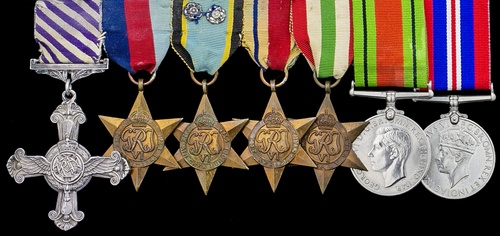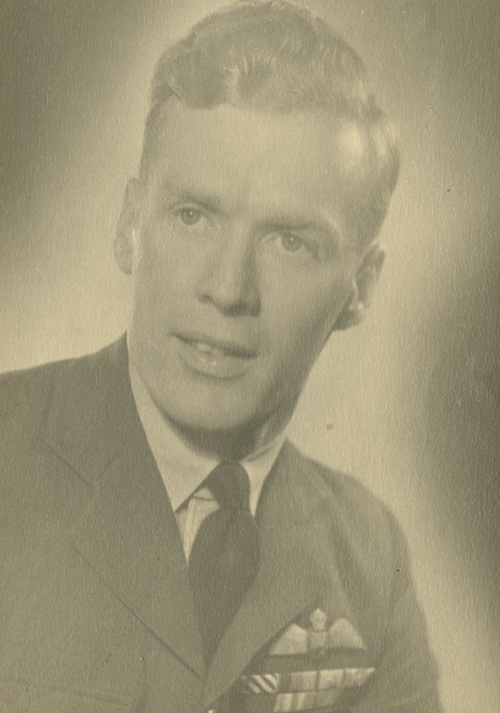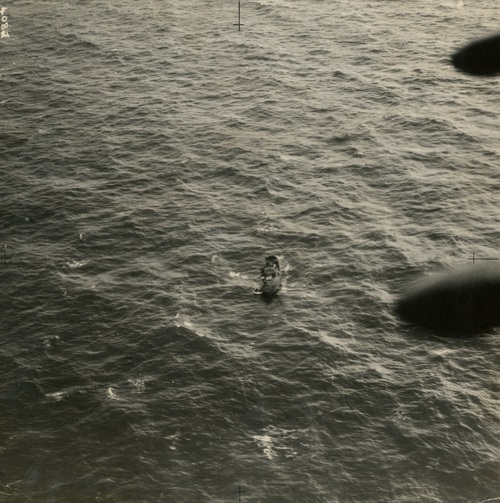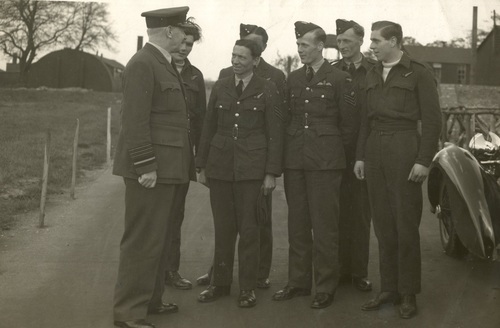Auction: 16003 - Orders, Decorations, Campaign Medals and Militaria
Lot: 16
SOLD BY ORDER OF A DIRECT DESCENDANT
Family Group:
A Fine Second War '1943' Wellington and Halifax Pilot's D.F.C. Group of Seven to Flight Lieutenant J. Bowman, Royal Air Force, Who Flew With No.102 and No.163 Squadrons, Awarded the D.F.C. For His 'Great Courage and Devotion' After Suffering Flak Damage Over Dortmund, Bowman Successfully Ditched His Damaged Halifax, Which Had Lost Three Engines at Sea, The Men Recovered Via the First Use of An Airborne Lifeboat, 4.5.1943, Crash-Landing Following Flak Damage, 30.8.1943 and Nose-Diving A Search Light Which Had Coned His Aircraft Over Freiburg, 6.9.1943
a) Distinguished Flying Cross, G.VI.R., reverse dated '1943', with Royal Mint, case of issue
b) 1939-1945 Star
c) Air Crew Europe Star, with two rosettes affixed to the riband
d) Africa Star
e) Italy Star
Defence and War Medals, light contact marks, very fine, together with the archive of related material:
- Three Pilot's Flying Log Books numbered 2-4 covering the dates 14.12.1942-5.5.1947, Log Book 1 confirmed as 'Lost in Middle East, 2.11.1941'
- Six photographs featuring the recipient
- Riband bar for the awards
- A '102 Squadron & 163 Squadron' scrap book compiled by the recipient, featuring annotated maps, detailed reports and images of each of the Operational Raids, covering the dates 5.5.1943-27.3.1945
- Letters from the recipient to his mother and sweetheart
- Original newspaper cuttings and related copied research
Three:
Driver J. Bowman, Royal Artillery
1914-15 Star (96415. Dvr. J. Bowman, R.F.A.); British War and Victory Medals (94616 Dvr. J. Bowman. R.A.), good very fine, together with a portrait photograph of the recipient (Lot)
D.F.C. London Gazette 22.10.1943 Pilot Officer James Bowman (148116), Royal Air Force Volunteer Reserve, No. 102 Squadron.
'This officer has completed a large number of sorties, many of them whilst serving in the Middle East. He has executed his tasks with skill and determination and his excellent example has proved a source of inspiration. On several occasions his aircraft has sustained damage by enemy action but each time, except on one occasion when he was forced to come down on to the sea, he
has- flown his damaged bomber to base. He has displayed great courage and devotion to duty.'
Flight Lieutenant James Bowman, D.F.C., (1923-2013), initially served as a Boy Messenger for the Air Raid Precautions in London during 1939. Although contemporaries were joined the 13th (Princess Louise's Own Kensington) London Regiment, a light machine-gun unit, Bowman's mother vetoed him this service during the Second War. A few days after his 18th birthday, Bowman was accepted into the Royal Air Force and selected for Pilot Training, initially upon Tiger Moths and Hampdens, undertaking training at Upper Heyford during December 1940, one example of the Pilot Cadet is featured in his typed memoirs:
'Posted to a Hampden training unit I was approaching air base one night when all lights on the aerodrome were extinguished. This was the signal that a German intruder was about. Suddenly, in my mirror, which gave me, a view of the tail, a bright light appeared. I corkscrewed and dived to no avail, the light was still on my tail. I managed to run into cloud but the light was still there. Only then did it dawn on me that it was a cockpit light behind me shining in my mirror!'
Posted to Wellington's in May 1941, Bowman then joined the newly formed No.148 Squadron in Cairo, August 1941. Details of the joyous conversion and transit to North Africa are recalled:
'Our detachment of 5 aircraft left Harwell for Cairo via Gibraltar and Malta. During our evening meal at Gibraltar, we gleaned there was a dance hall close by. We were naive enough to think that Spanish girls would be available as partners. The dance floor was crowded, with not a girl in sight, only Royal Navy sailors enjoying waltzes and quicksteps.
Such was the state of preparedness in 1941 that our aircraft had to be refuelled by 4 gallon cans of petrol which, when emptied, were rolled down the wing onto the tarmac. As our tents were close by, we had little sleep.
We were pleased to take off for Malta early next morning flying below 100ft. to make detection difficult. Between Pantellaria, a German fighter base, and Sicily, the rear gunners' turret touched the top of a wave. His shout told me he was not amused.
Landing at Luqua, Malta, we were marshalled at break neck speed to a dispersal, just in time, as the airfield was bombed within minutes. Early next morning we set off for Abu Suer, near Cairo; all landed safely except one who had undercarriage problems. Whilst we were watching the crash, an airman approached us and said he had to collect our issued Omega watches. Naively we handed them over. We saw neither him or our watches again! This was our salutary introduction to the land of the Pharaohs.'
Following his arrival into the North African campaign, Bowman completed raids to Tripoli, Benghazi and the Minig Corinth Canal. His time was cut short however following a crash landing, 2.11.1941, recalling:
'November 1941, the target for tonight being Benghazi, Libya, necessitated a 200 mile flight to a desert landing ground to refuel, followed by a 900 mile round trip to Benghazi. On our return to LG104, our desert Air Traffic Control, with the whole area under dense fog and no alternative airfield available, refused to answer our radio calls. With fuel running low, each individual crew were left to make their own decisions. Two aircraft ditched in the Mediterranean, two bailed out and we decided to land on a salt lake to the south of Mersa Matruh. Still in thick fog, we scraped along the escarpment north of the salt lake. I was the only casualty losing the sole of my left foot. Mid-morning, when the sun had dispersed the fog, a lone Hurricane spotted us, transmitted our position to base who arranged transport which arrived at night-fall.
After a month in hospital I joined a hospital ship at Suez bound for Durban. My foot showing signs of gangrene, the ship drew into calm waters to enable the surgeon to amputate. After parking and cleaning the wound, it was decided to await further developments. Thanks to his expertise and sympathetic action, my foot and my future was saved and we continued to Durban where specialists spent seven months restoring my "soul". Arriving in Glasgow early in 1943, after training, I joined 76, a Halifax Squadron, the Wing Commander being the legendary Leonard Cheshire. He was an observer on the Super Fortress which dropped the atomic bomb on Hiroshima and was so affected by the experience that he left the RAF, to establish the Cheshire Homes. A charismatic leader with an amazing memory for names, he was always remain my war, and peace, hero.'
Log Book 3 confirms the loss of Log Book 1, stating 'Estimate of hours completed in No.1 Log Book lost in Middle East 2nd November 1941. Nav. Hrs. 44 1/2 day 4 night'.
Bowman joined No.76 Bombardment Squadron, No.4 Aggression Group, 22.3.1943. His first Operation was that same evening, over St. Nazaire, completing another to Duisberg, 26.3.1943.
No.102 'Bombardment' Squadron
From 1.5.1943, Bowman joined No.4 Aggression Group, based at Pocklington. During his first Operation, as Pilot, 4.5.1943, his Halifax crew completed a raid on Dortmund, however the return journey was not so simple. The Log Book states 'Ops. Dortmund. Lost 3 Engines. Ditched 90 miles S.E. Flam. Head. Hudson 279 Squadron. Air-Borne Lifeboat Dropped- 1st Time'
Being hit by flak over the position, losing two engines the aircraft was '...Down to 8000ft over Zuider Zee and both remaining engines running roughly. The 2 port engines overheated- lost another, decided to ditch in North Sea 100 miles from English coast. Thick mist and S.O.S. signal stopped as trailing aerial touched sea. Remember standing on seat with top window open as waves swamped over me. Dingy in wing had not appeared. Dived down to free dingy- bring A/C back at all cost- not tow it. 3a.m.-7.30 Hudson flew over on way to Skagerak for weather. Saw our Verey light flares and circled. It only just missed us. History was made as this was the first operational dropping of airborne lifeboat (designed Uffa Fox). Secret.'
Following their ditching, his sweetheart (whom later he married), received the following telegram 'Regret to inform you that your friend 1180438 F/Sgt J Bowman is missing as a result of Operations on night of 4/5th May 1943. Any further information will be immediately communicated to you. O/C 102 Squadron.'
The crew were eventually rescued and returned to Squadron, where they received a welcome from Marshal of the Royal Air Force Sir Arthur Travers 'Bomber' Harris, 1st Baronet, GCB, OBE, AFC. A newspaper cutting provides further first hand reports from Bowman '...We were badly shot up over the target and three engines were put out of action. We ditched successfully and waited for help but never expected such a surprise...I've never been so frightened in my life as when this great boat came sailing down towards us in our rubber dingy. We were sure it was going to hit us, it dropped so close. However, it landed all right and we soon scrambled in. I could hardly believe my eyes when I saw it had engines. We got them going in a few minutes and they helped us forward for several hours at about six knots. The Hudson aircraft which dropped the boat flashed us our course and we had got within about 10 miles of England when we were met by a Naval vessel. We were given air protection the whole way back.'
Bowman completed 28 Operational Sorties to the end of September 1943, including Berlin, Dortmund, Essen, Cologne, and Mannheim. Bowman was also present during the Hamburg 'Firestorm' Raid, 24.7.1943, on the Milan Raid, 12.8.1943, as Special Reconnaissance for heaviest Bomber Command raid on Italy during the Second War and also at Peenemunde, 17.8.1943.
During the Peenemunde Raid, 17.8.1943, the Log Book notes 'Dingy Sighted- Position Fixed & Radioed). The events of the Raid are recalled:
'The full moon period was usually a stand down for heavy bombers and after a strenuous late July and early August we were looking forward to some good nights's sleep. We were surprised to be called to a briefing at 1930 on 17th August 1943. Extra security was apparent and the presence of the Group Captain ensured the importance of the Target for Tonight. Hoping that it was not a moonlight visit to Big City, Berlin, we were pleasantly surprised to find the target was Peenemunde, a village on the island of Us Edom in the Baltic, 130 miles north of Berlin. We were informed that 600 aircraft carrying 1800 tons of bombs were to wipe out a highly specialised radar research establishment. We were to bomb, not at our usual 18,000ft, but at 6,000ft to ensure accuracy and were warned that the raid would be repeated as long as necessary regardless of casualties.
Routing via Esbjerg, Denmark, we could see the lights of southern Sweden as we cruised in bright moonlight over the Baltic Sea. Dropping down to 6,000ft, the red pathfinder marker flares marked the target and we dropped our 3 ton load of bombs. Normally from 18,000ft we were unaware of the percussion effect from the bombs, but at 6,000ft, the Halifax shook. Climbing away, German ME110's and 109's criss-crossed our path as we sped away and 40 aircraft were lost. It would have been more but a Mosquito raid on Berlin had been synchronised with the Peenemunde raid and Luftwaffe fighters over Berlin took 30 minutes to make contact. 23 Lancaster's, 15 Halifax's and 2 Sterling's were lost. 6 of the Lancs were brought down by upward firing cannons from ME110 fighters, one of which accounted for us a fortnight later. Back at Pocklington, after the 7 hour flight, we learned that our target had been the V1 and V2 rocket development and test site.'
Another engagement followed, 30.8.1943, following Operations over Gladbach. Bowman had endured an extremely busy summer of Operations. The Log Book notes 'Ops. Gladbach. Landed Wittering Flaps O/S. Badly shot up by M.U. Halifax. 20mm. cannon shell found in parachute'. The exact nature of the events are recalled:
'August 20th, 1943, my engineers had spent all day arming, refuelling and fussing over me for my 26th Sortie with my crew of seven airmen. At maximum take-off weight I staggered into the air at Pocklington, near York just before 6 o'clock on a warm summers evening. Climbing ponderously on course to 18,000ft, I began to muse over my previous trips with my present aircrew notably, Berlin, Hamburg and the V1, V2 Island of Peenemunde. Remembering that this was my 13th Sortie to the Ruhr, hoped my luck would last.
Homeward bound, soon after leaving the target I picked up a signal from our radio pulse receiver, nicknamed "Monica", indicating a possible fighter interception. Corkscrewing, diving, climbing was very tiring and I was pleased to hear Shorty, my Bomb Aimer, call that he could see a sister Halifax which was triggering Monica. He was wrong; it was a Luftwaffe M.E.109 stalking me with vertically firing cannon which, as I levelled out fired a fusillade of shells into me. Trig, the Mid Upper Gunner has his steel seat shattered, his Perspex cupola disintegrated, the parachute he was sitting on ruined, but Trig unscathed. One of my petrol tanks ruptured and fuel lost, my hydraulic lines and reservoir were emptied which meant no power for lowering landing wheels or wing flaps and no brake pressure. A complete loss of radio and electrical power meant that radio telephony communication was impossible and we were not transmitting our identification to our Night Fighters or defence system. Miraculously my four Merlins were functioning and the Captain, having given thought to the not braking situation asked Danny, the Navigator to set course for Wittering which, at that time consisted of two grass aerodromes joined together.
Lowering the landing gear without hydraulic power meant diving steeply and pulling up sharply to allow the heavy elastic bungee cables to snap the undercarriage into a locked position. I had never tried this procedure before but it worked. Now all I had to do was to gain the attention of the Wittering Airfield controller. Flying over the filed, the two carriages selected as the coded colours of the period were fired from the Verey pistol and I cheered with my crew when the runway lights were switched on. Without wing flaps I had to approach much lower and faster than normal. I touched down with a sign of relief which was short lived as the runway lights were suddenly extinguished, and I found myself tearing into darkness. My crew cut the fuel flow to the four Merlin engines and in the ensuing silence, with no braking facilities, I awaited the appearance of a stout oak tree. My fears were groundless and I trundled and trundled on the grass and then, glory be, stopped.
My crew thankfully disembarked and waited for the fire, ambulance and transport services. Nothing appeared out of the darkness and the Captain and the Navigator left to find and alert the aerodrome authorities. I was told later that when they climbed the steps to the Watch Office the startled Airfield Controller's mouth dropped. It appeared that he had not seen our Verey light flares; he had switched on the runway lights to allow a night fighter Beaufighter to land and had turned the lights off when the aircraft has cleared the runway. I of course had landed without landing lights and my crews sudden appearance, appeared to the Controller to be supernatural. I was eventually towed back to the hanger but my damage was so severe that I never flew again, but my Merlin engines and spare parts came in useful.
News filtered through that the Mayor of Peterborough had arranged a Civic Reception to hear my crews story that seemed improbable.'
His 27th Operational Sortie was no less eventful, the Log Book for 6.9.1943 stating 'Ops. Munich. Landed Hartfordbridge. 3 Cannon holes. JU88 Destroyed'. Once again "Monica" was in use, as written and published by the recipient in July 2004:
'...our Halifax "W" Whisky was returning from bombing Munich, when our interrogation device, nicknamed "Monica" indicated the attention of a German night-fighter. Monica's pips rapidly increased as the fighter closed in and I began a violent 'corkscrew'. Cannon shell thuds on the fuselage were followed by a reply from Trig Tregunno, in the top turret, and Johnny Prinsloo in the rear. We've got him yelled Johnny and I saw a ball of flame explode on our right hand side.
Our elation was short lived, having lost a couple of thousand feet of height in the encounter, I had started to climb when "Monica" warned us of the approach of another night-fighter, Johnny shouted 'I can see her, turn port.....NOW'. No shots were fired as I whipped our Halifax round to the left. Three further attacks were made forcing us well south of our track and more height lost. At around 13,000 feet a sudden burst of flak was followed by a master searchlight, pale blue in colour, capturing us, to be followed by more beams. We were "CONED". We were nearing the end of our Operational tour of 30 Sorties and had witnessed many colleagues in a similar situation and inevitably of their fate from night fighters. Our pursuing fighter had manoeuvred us over the centre of Freiburg where he could await the searchlight coning.
Realising our parlous position, I felt that we had to try to extinguish the searchlights. Closing the throttles I pointed the Halifax down the master searchlight beam and shouted for Jack Loveless our front gunner to fire his gun. We saw the searchlight crews scatter as I poured on the power to level out above the trees of the Black Forest. I remember our Wireless Operator, Charlie Parry quietly asking, "What's our heading Jim?" "Due west" was my reply, "Thank the Lord", Charlie muttered.
Having wasted fuel at low level we were forced to land at Hartford Bridge to refuel and have the cannon holes repaired, returning to Pocklington, Yorkshire, the next day.'
His tour of 30 Operational Sorties was completed, 28.9.1943, over Bochum, his tally being one destroyed (6.9.1943) and one damaged (23.9.1943).
Bowman married his sweetheart, Betty, in 1944 and continued in service during the Second War with the Pathfinder Force. Bowman continued in aviation following his career with the Royal Air Force, flying for British Airways, and later Tradewinds, retiring in 1980. He presented Uffa Fox with the 'scroll' upon the BBC Television Series, 'This Is Your Life', 29.1.1963. Bowman died, 12.3.2013.
96415 Driver John Bowman, was the father of Flight Lieutenant James Bowman, D.F.C.; served with the Royal Field Artillery during the Great War on the Western Front.
Subject to 20% VAT on Buyer’s Premium. For more information please view Terms and Conditions for Buyers.
Sold for
£2,800













